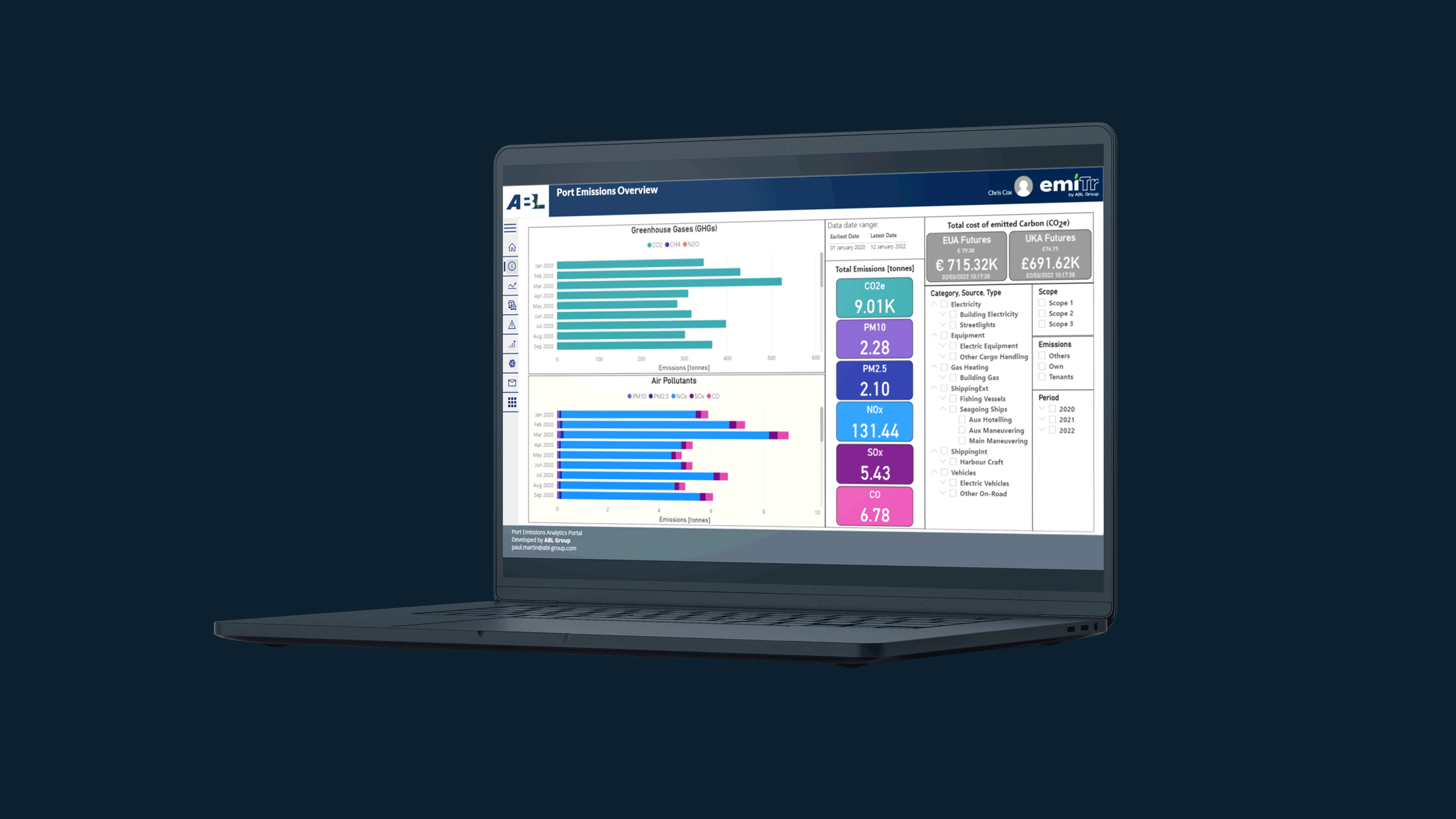Emissions Consulting
Between 80 and 90% of everything we consume is moved by sea. The shipping industry produces around 940 million tonnes of CO2 annually – making up at least 2.5% of the total emissions worldwide, roughly equivalent to the total emissions of a country the size of Germany. It is, therefore, unsurprising that regulations on emissions, such as the EU Emissions Trading System, are beginning to be applied to the maritime industry in the fight against climate change. Whilst marine facilities such as ports are not currently impacted by these regulations, they are likely to be expanded further across the maritime industry over time.
Emissions are categorised into one of 3 ‘scopes’ as per the Greenhouse Gas Protocol:
- Scope 1 – Direct emissions that are under control of a port. For example, harbour-owned craft and vehicles
- Scope 2 – Indirect emissions that are also under control of a port. Examples include electricity purchased for buildings and streetlights
- Scope 3 – All other indirect emissions that are not included in scope 2. For example, emissions generated by tenants of the port and, crucially, ships, with 85% of these emissions attributable to bulk, container and oil vessels
Broadly speaking, but not always, ship emissions constitute upwards of 70% of a port’s total emissions. And in total, 6% of all shipping emissions in the EU occur when ships are at berth. Ports form an inextricable part of the shipping value chain and are contributors to the maritime sector’s emissions. They are coming under pressure from stakeholders such as the local community to decarbonise, and potential market-based measures (taxes on CO2 emissions) could be ahead.
Strategies to reduce emissions
Electric vessels
Whilst ports cannot change the propulsion systems on seagoing ships, they can make use of electric harbour craft to reduce their Scope 1 emissions.
Electric vehicles and equipment
As with vessels, replacing existing fuel-powered vehicles and equipment with electric ones will reduce emissions and operating costs.
Renewable energy sources
Using onshore or offshore wind, solar and hydroelectric energy sources can help ports become a standalone infrastructure from the national electrical grid or at least cover a portion of their energy needs.
Surcharges on high-emission ships
Some ports, such as the Port of Hamburg, target high-emission ships with increased port fees and provide discounts to low-emission ships. This not only reduces the emissions in port but also puts pressure on ship owners to reduce their emissions.
Cold ironing (shore power)
A high-cost solution which provides electricity to berthed ships to enable them to turn off their auxiliary engines when hotelling. Potentially reduces a large portion of a port’s emissions with the added benefit of noise reduction but not suitable for all ports. This would not be a suitable solution for all ports due to the size and type of vessels being served.
Alternative fuels
A range of possible alternative fuels exist, each with its own advantages and disadvantages
- Liquid natural gas (LNG) / liquid propane gas (LPG)
- Biofuels: Renewable fuels such as fatty acid methyl ester (FAME) or biodiesel
- Gas-to-liquid (GTL)
- Hydrogen
Just-in-time arrival
AI and digitalisation of ports can reduce the time ships spend at anchor waiting for a berth at a port and also allow ships to reduce emissions whilst en route to the port with the possibility of travelling at slower speeds. This is an ideal solution for a port which receives calls from larger vessels than those at Shoreham.
Energy-efficient ship handling
Pilots at a port can undergo training in the practice of operating ships more efficiently to help reduce emissions during the manoeuvring phase. This is a relatively simple and low-cost strategy to implement, and with 37% of ship emissions being produced during transit and manoeuvring at Shoreham Port, there could be scope for some reductions.
Every port is different, and therefore there is no single set of strategies which can be applied to reduce emissions. Therefore it is important for ports to calculate where their emissions are generated in order to identify the emission reduction strategies which are both cost-effective and environmentally impactful.
Our services
ABL Group has been working in collaboration with Shoreham Port in the UK to develop and deploy a portal for calculating and tracking emissions on a routine basis – emiTr.
“We are delighted to be working with the team at ABL Group, who are helping us make the identification and tracking of our emissions simple and straightforward to do. This is important data for us to understand the impact we make, and we will use this data to inform decisions in the future as we aim to improve our energy efficiency and reduce pollution across the Port’s footprint.”
Shoreham Port
- emiTr allows users to enter the fuel/electricity usage of all their port’s assets. The portal then automatically calculates emissions based on the already collected emissions factors and formulae.
- Emissions from vessels within the port boundaries can be calculated automatically from AIS data.
- Emissions of both greenhouse gases (e.g. Carbon Dioxide, Methane, Nitrous Oxide) and pollutants (e.g. Oxides of Nitrogen, Oxides of Sulphur, Particulate Matter, Carbon Monoxide) are calculated to give a comprehensive overview of a facility’s emissions profile.
- These results can then be accessed online as interactive charts with filters by emission sources, and scopes, including or excluding tenants and by date periods.
- The monetary value of the CO2 emissions based on carbon credit schemes such as the EU ETS is also shown – an indication of the kind of costs a port may face if market-based measures are implemented in the future
A web-based portal such as emiTr can help ports and other maritime facilities such as shipyards, offshore wind sites, and even the oil and gas industry to get ahead of the curve and identify their carbon footprint so they can take informed actions.
- Each type of emission can be investigated to view the sources of them
- Date-based graphs allow users to identify trends
- Over time, the effectiveness of emission reduction strategies can be illustrated using these charts
- A full asset list can also be viewed, with the emissions of each item displayed
- This gives the port sufficient granularity in its results to identify specific sources of high emissions and the ability to monitor particular pieces of equipment in detail
With emiTr, data can be entered routinely by users to make the complex task of generating a full emissions breakdown straightforward.
Download our flyer for more information on emiTr, and for contact details to request a demo.

“The first step in any capital expenditure decision-making regarding infrastructure spend relating to emissions reduction is to have a clear picture as to what existing emissions are and where they are coming from. Port emissions are a complex web, which is produced both directly and indirectly within a port’s jurisdiction, and it is essential to map these out.”
Paul Martin, ABL Maritime Director
Though designed with ports and harbours in mind, emiTr is highly configurable and flexible to support any industry and company across the marine sector in tracking and calculating their emission profile. It could, for instance, be configurable to support offshore oil & gas operations and offshore wind T&I operations, among other areas.

